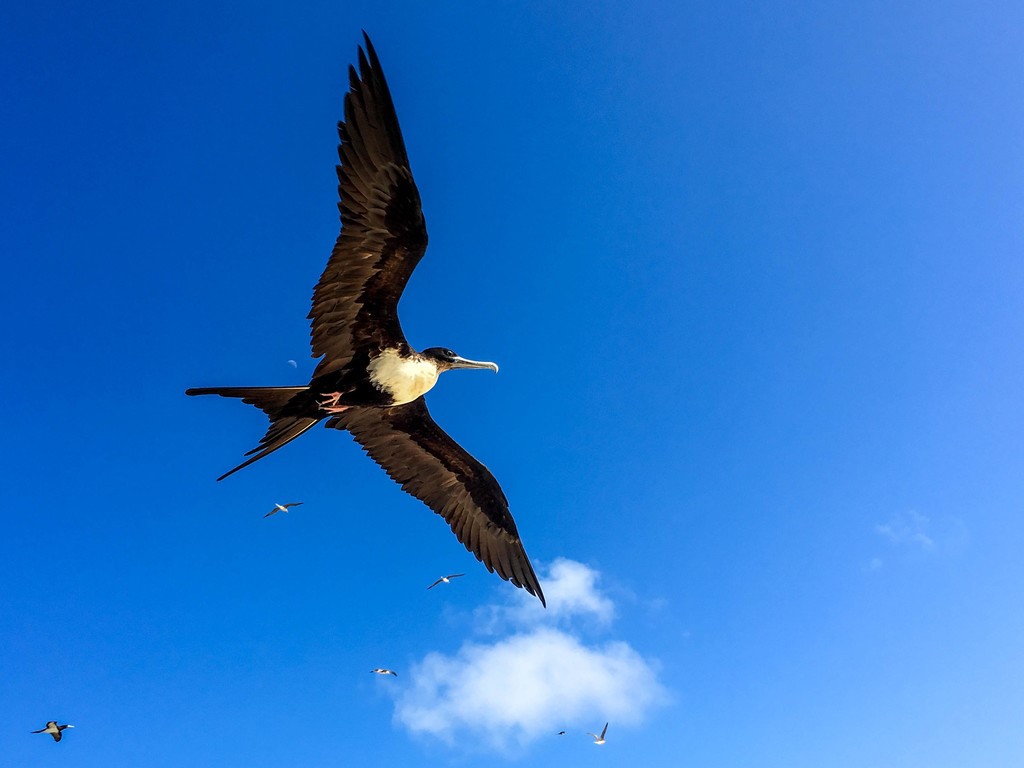Birdfinding.info ⇒ The predominant frigatebird throughout most of the central and eastern Pacific Ocean—but very rarely detected east to the American continent (where it may be overlooked due to its similarity to Magnificent Frigatebird). Locally common in the archipelagos where it breeds, including Hawaii, the Galápagos, and French Polynesia. Rare along most coasts the western Pacific and Indian Oceans, and nearly extirpated from the Atlantic altogether. In Hawaii it can be found along the coasts of all the main islands, especially on Kauai and Oahu. Consistent sites include: on Kauai, Kilauea Point National Wildlife Refuge (for close views), Hanapepe, and Poipu; on Oahu, Makapu’u Point and Ka’ena Point; on Maui, Ke’Anae and Wai’anapanapa State Park; and on the Big Island, Pololu. In Australia, it can usually be found on certain islands of the Great Barrier Reef, such as Michaelmas Cay near Cairns and Lady Elliot Island (offshore from Gladstone).
Great Frigatebird
Fregata minor
Pantropical, from the South Atlantic to the eastern Pacific Ocean.
Breeding. Mainly on remote tropical islands nearly throughout the central and eastern Pacific, from the Marshall Islands and Hawaii south to Fiji and east throughout Polynesia to Mexico’s distant islands (Clipperton and San Benedicto), Cocos Island, the Galápagos, and Sala-y-Gomez Island.
In the western Pacific, breeding sites are smaller and more dispersed, including a few islets in the South China and Sulu Seas, Palau, the Bismarck Archipelago, and islets around New Caledonia.
In the Indian Ocean, there are colonies on Europa, the Seychelles, the Chagos Archipelago, the Cocos (Keeling) Islands, Christmas Island, and Ashmore Reef (Timor Sea).
In the South Atlantic, breeds on Trindade and possibly also on Martin Vaz—this population is critically endangered and appeared to be down to a few individuals in the 2010s.
Nonbreeding. Wanders year-round throughout the tropical Indian and Pacific Oceans from eastern South Africa to the Galápagos.
Present at low densities throughout much of Indonesia and the waters around Australia. Rare and sporadic north to waters around Taiwan and southern Japan.
Accidental in the U.S., with two or three records from coastal California and an exceptional record from Oklahoma.
Identification
The most widespread frigatebird and generally the most likely to occur with, and be confused with, other species. Despite its name, Great is actually a middle-sized frigatebird by the measurements (larger than Lesser, smaller than Magnificent).
Acquires its definitive adult plumage over the course of several years, resulting in six more or less distinct plumages: juvenile, older immature, and the subadult and adult plumages of each sex.
Although the upperparts are mostly black or blackish-brown in all plumages, each wing has a blond “alar” bar that extends from the wrist back along the coverts toward the rump. For some plumages, this blond wing bar can help in identification.

Great Frigatebird, male. (Christmas Island; July 9, 2017.) © Hickson Fergusson
Adult Male. Adult male has all-blackish plumage, and is therefore effectively identical to adult male Magnificent and (dark morph) Ascension Frigatebirds.
In strong light, certain feather groups reflect some iridescence, usually greenish or purplish.
Like all male frigatebirds, it has a bright-red throat-pouch, which it inflates like a balloon during mating and dominance displays, but can be inconspicuous when deflated.
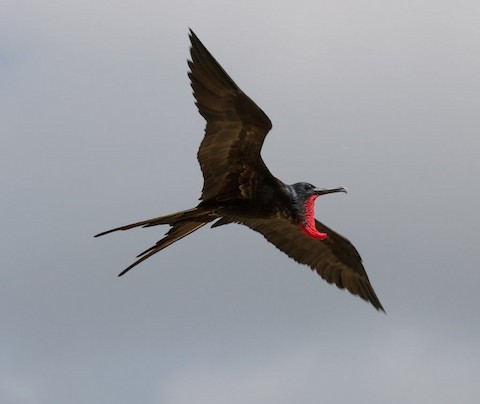
Great Frigatebird, male with drooping deflated throat-pouch. (Christmas Island; July 9, 2017.) © Hickson Fergusson

Great Frigatebird, male flying with fully inflated throat-pouch. (Isla Genovesa, Galápagos, Ecuador; June 20, 2018.) © Rich Wolfert

Great Frigatebird, male. (Kilauea Point National Wildlife Refuge, Kauai, Hawaii; May 3, 2016.) © Jacob Drucker
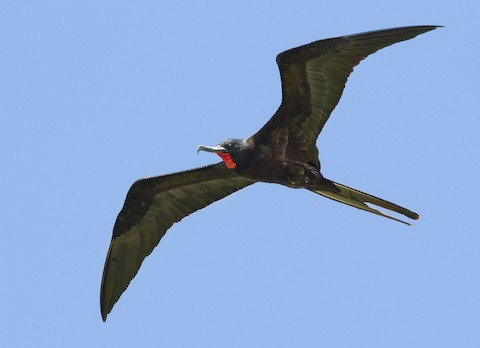
Great Frigatebird, male. (Tench Island, New Ireland, Papua New Guinea; July 13, 2014.) © Lars Petersson
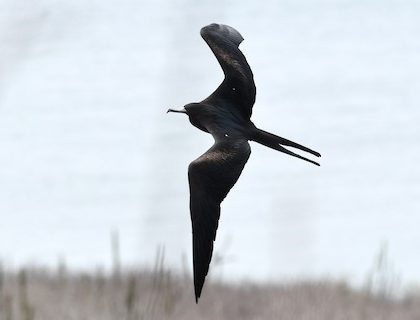
Great Frigatebird, male, showing faintly paler alar bars on upperwings. (Cerro Tijeretas, Isla San Cristóbal, Galápagos, Ecuador; November 24, 2019.) © David M. Bell
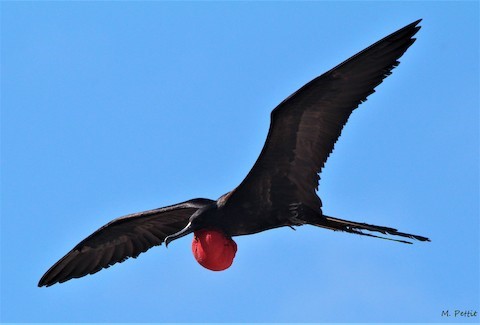
Great Frigatebird, male with partly inflated throat-pouch. (West Island, Ashmore Reef, Western Australia; April 29, 2019.) © Magen Pettit
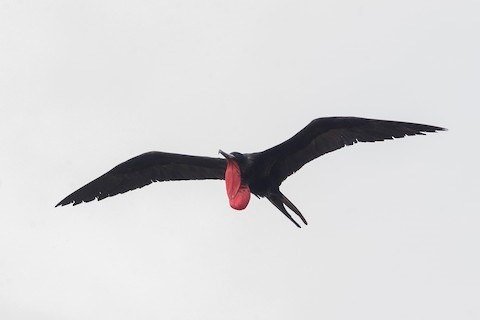
Great Frigatebird, male with partly inflated throat-pouch. (Olivers Hill Lookout, Frankston, Victoria, Australia; June 10, 2016.) © Owen Lishmund

Great Frigatebird, male with inflated throat-pouch. (Christmas Island; April 29, 2018.) © Hickson Fergusson

Great Frigatebird, male. (Nukuloa, Wallis and Futuna; August 16, 2015.) © Thierry Nogaro

Great Frigatebird, male showing green gloss on head and back. (North Seymour Island, Galápagos, Ecuador; March 25, 2018.) © John Reynolds

Great Frigatebird, male showing pale alar bar on wing. (Aride, Seychelles; November 8, 2018.) © Tom Lansley

Great Frigatebird, male, nest-sitting. (North Seymour Island, Galápagos, Ecuador; March 25, 2018.) © John Reynolds

Great Frigatebird, male showing loose, deflated throat pouch. (Isla Genovesa, Galápagos, Ecuador; May 5, 2019.) © William Richards

Great Frigatebird, male showing green gloss on head and back. (Isla Genovesa, Galápagos, Ecuador; July 10, 2011.) © Rhys Marsh
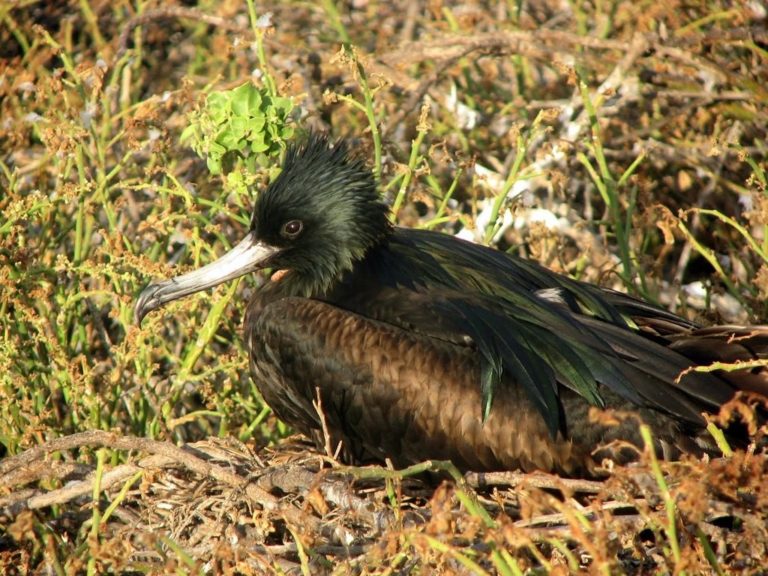
Great Frigatebird, male showing green gloss on head and back. (North Seymour Island, Galápagos, Ecuador; June 27, 2007.) © Andy Frank

Great Frigatebird, male. (Picard, Seychelles; December 5, 2018.) © Christophe Gouraud

Great Frigatebird, male. (Jakarta Bay, Java, Indonesia; August 5, 2018.) © Matthew Kwan

Great Frigatebird, male with throat-pouch deflated after displaying. (Hatutu, Marquesas Islands, French Polynesia; May 19, 2006.) © Marvin Hyett
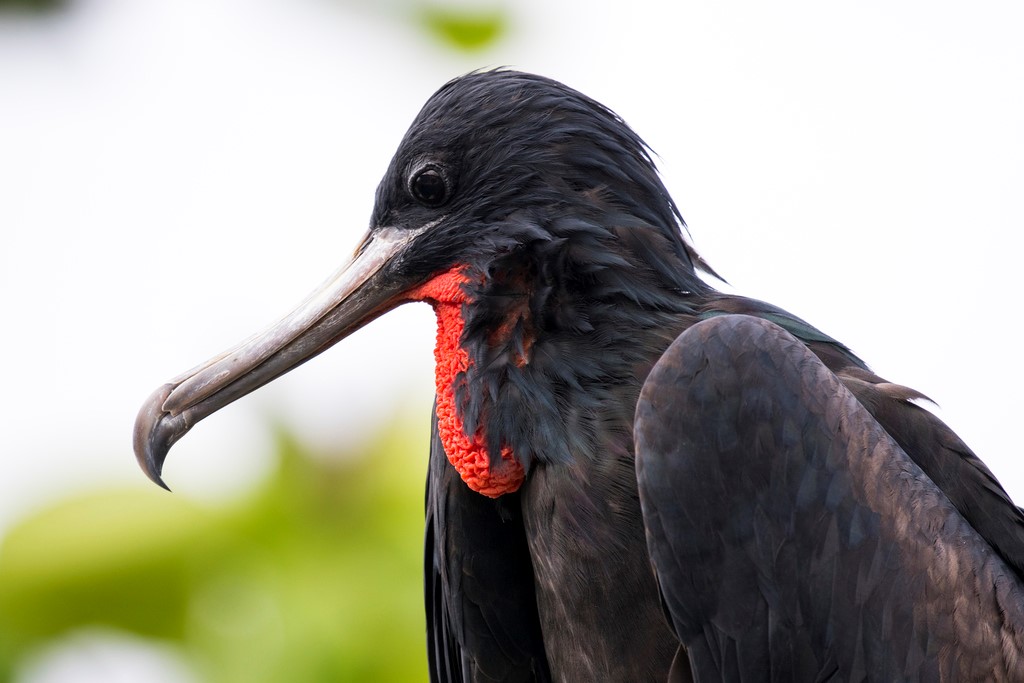
Great Frigatebird, male with throat-pouch deflated after displaying. (Christmas Island; December 23, 2019.) © hokoonwong

Great Frigatebird, male displaying and showing green gloss on head and back. (North Seymour Island, Galápagos, Ecuador; May 22, 2014.) © Douglas Gimler
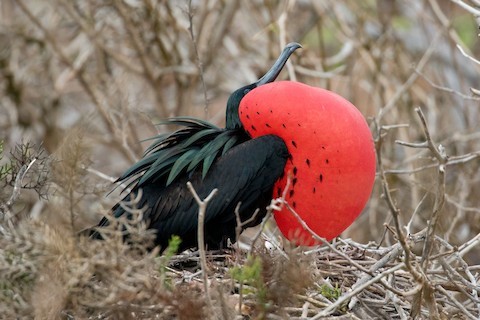
Great Frigatebird, male displaying, with throat-pouch maximally inflated. (North Seymour Island, Galápagos, Ecuador; March 25, 2018.) © John Reynolds
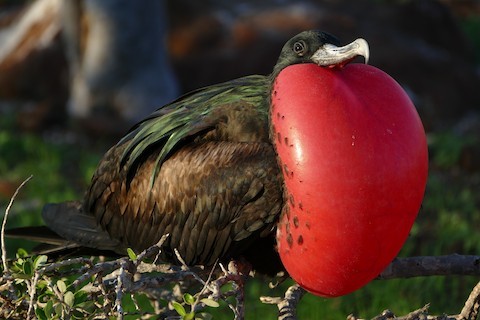
Great Frigatebird, male displaying, with throat-pouch maximally inflated. (North Seymour Island, Galápagos, Ecuador; March 31, 2017.) © Peter Kaestner
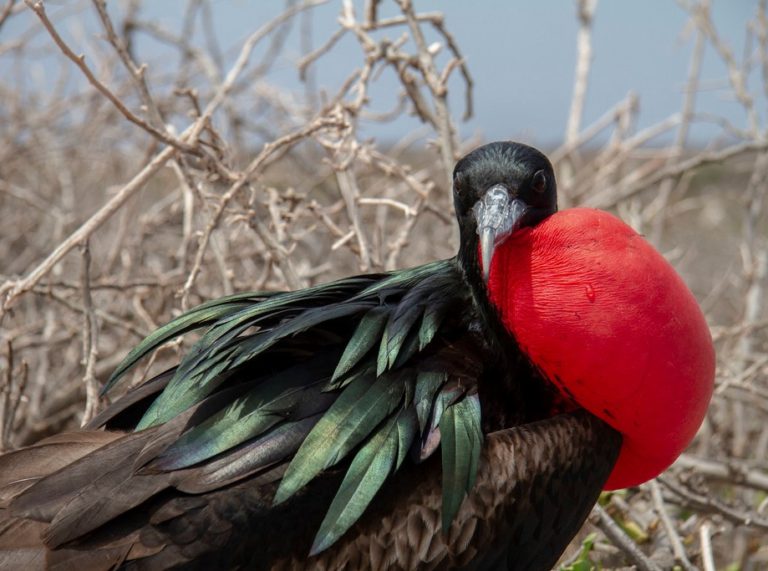
Great Frigatebird, male displaying and showing green gloss on back. (Isla Santa Cruz, Galápagos, Ecuador; March 20, 2016.) © Andrés León-Reyes

Great Frigatebird, male displaying and showing atypically purplish (not green) gloss on back. (Laysan Island, Hawaii; January 8, 2012.) © Cameron Rutt
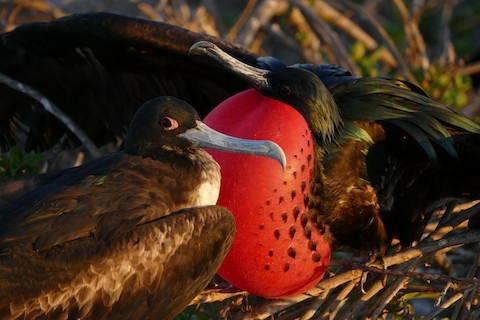
Great Frigatebird, male displaying to female. (North Seymour Island, Galápagos, Ecuador; March 31, 2017.) © Peter Kaestner
Adult Female. Adult female is mostly blackish with a large white area on the breast and throat.
Females of most populations have a pinkish bill and eyering. However, those of the southwestern Pacific have a bluish-gray bill and eyering.
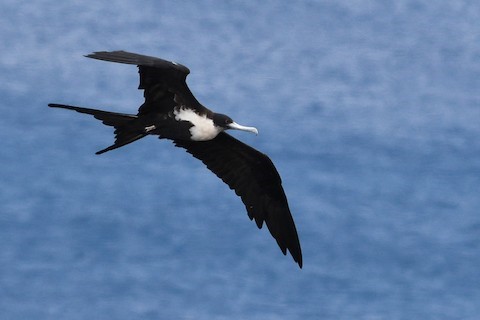
Great Frigatebird, female. (Cerro Tijeretas, Isla San Cristóbal, Galápagos, Ecuador; November 24, 2019.) © David M. Bell
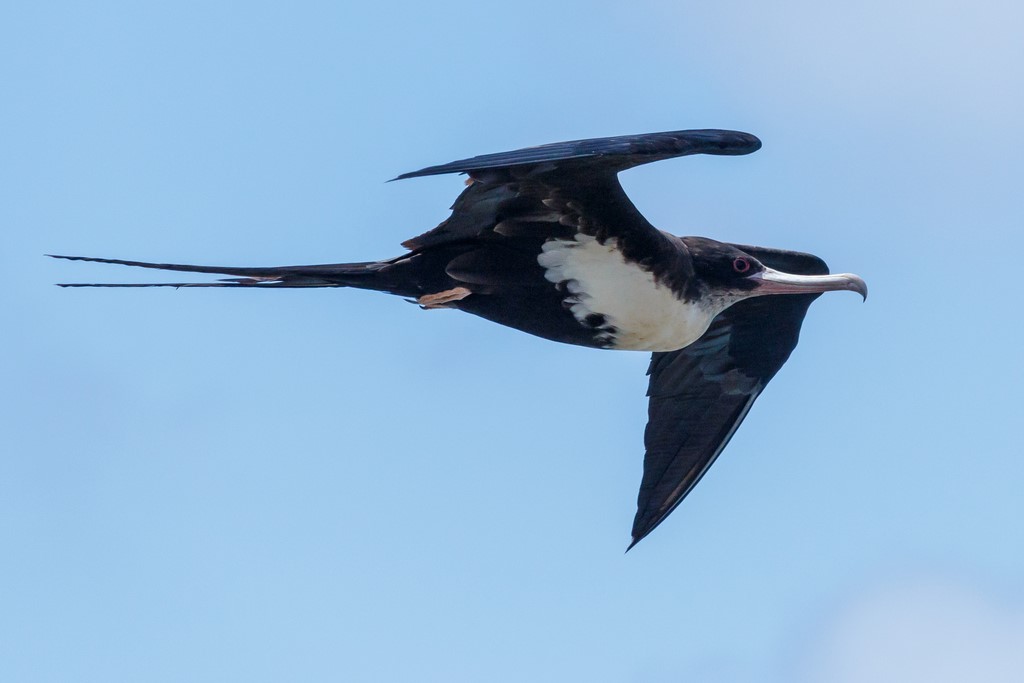
Great Frigatebird, female with pinkish eyering and bill, as is typical of most populations. (Kilauea Point National Wildlife Refuge, Kauai, Hawaii; June 23, 2016.) © Meghan Cassidy

Great Frigatebird, female with bluish eyering and bill, as is typical of southwestern Pacific populations. (Michaelmas Cay, Queensland, Australia; November 19, 2017.) Anonymous eBirder

Great Frigatebird, female showing gray (not white) throat. (Michaelmas Cay, Queensland, Australia; January 17, 2020.) © Matthew Kwan
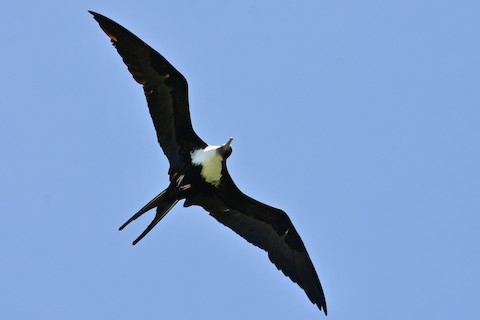
Great Frigatebird, female. (Peleliu, Palau; April 13, 2019.) © Rosemary Joganic

Great Frigatebird, female chasing a Yellow-billed Tropicbird. (Kilauea Point National Wildlife Refuge, Kauai, Hawaii; June 9, 2018.) © Sharif Uddin
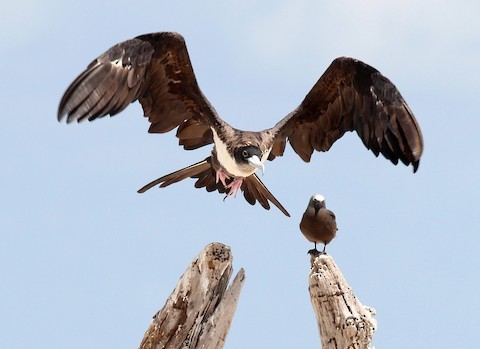
Great Frigatebird, female, looming over a Brown Noddy. (Michaelmas Cay, Queensland, Australia; October 19, 2016.) © Hal and Kirsten Snyder
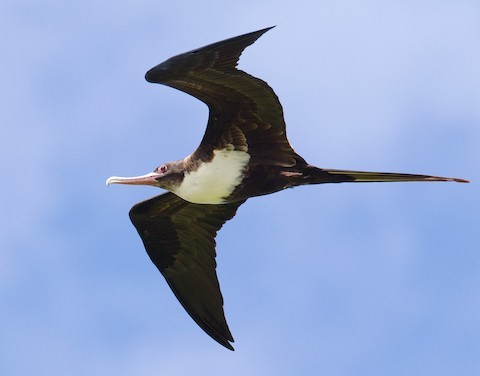
Great Frigatebird, female with pinkish eyering and bill, as is typical of most populations. (Tench Island, New Ireland, Papua New Guinea; July 13, 2014.) © Lars Petersson
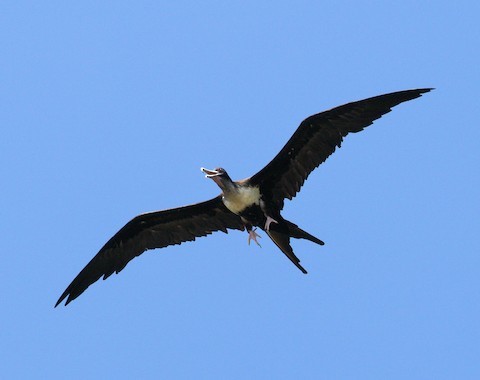
Great Frigatebird, female with gray (not white) throat and showing pink feet. (Flying Fish Cove, Christmas Island; August 9, 2015.) © Ian K. Barker

Great Frigatebird, female. (Michaelmas Cay, Queensland, Australia; September 6, 2015.) © Margot Oorebeek

Great Frigatebird, female showing pale alar bars. (Cerro Tijeretas, Isla San Cristóbal, Galápagos, Ecuador; November 24, 2019.) © David M. Bell

Great Frigatebird, female showing a pale collar and pale alar bars. (Kilauea Point National Wildlife Refuge, Kauai, Hawaii; March 24, 2018.) © Russ Morgan
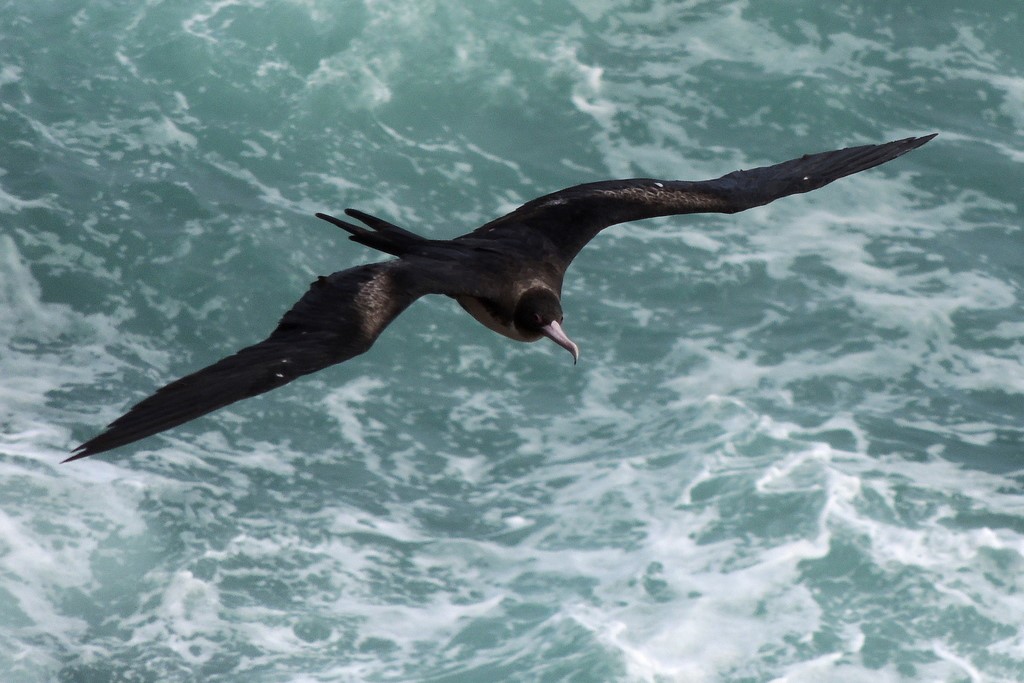
Great Frigatebird, female showing a subtly pale collar and pale alar bars. (Kilauea Point National Wildlife Refuge, Kauai, Hawaii; November 14, 2013.) © anita363

Great Frigatebird, female showing a pale collar and pale alar bars. (Aride, Seychelles; October 22, 2019.) © Oscar Campbell

Great Frigatebird, female showing a pale collar and pale alar bars. (Kilauea Point National Wildlife Refuge, Kauai, Hawaii; May 20, 2017.) © Sharif Uddin

Great Frigatebird, female showing a pale collar and pale alar bars. (Kilauea Point National Wildlife Refuge, Kauai, Hawaii; May 14, 2020.) © Eric VanderWerf
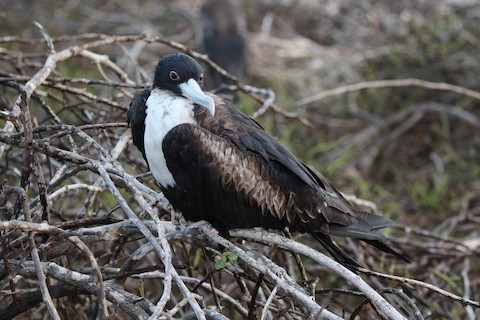
Great Frigatebird, female showing pale alar bars. (North Seymour Island, Galápagos, Ecuador; December 20, 2017.) © Richard Greenhalgh
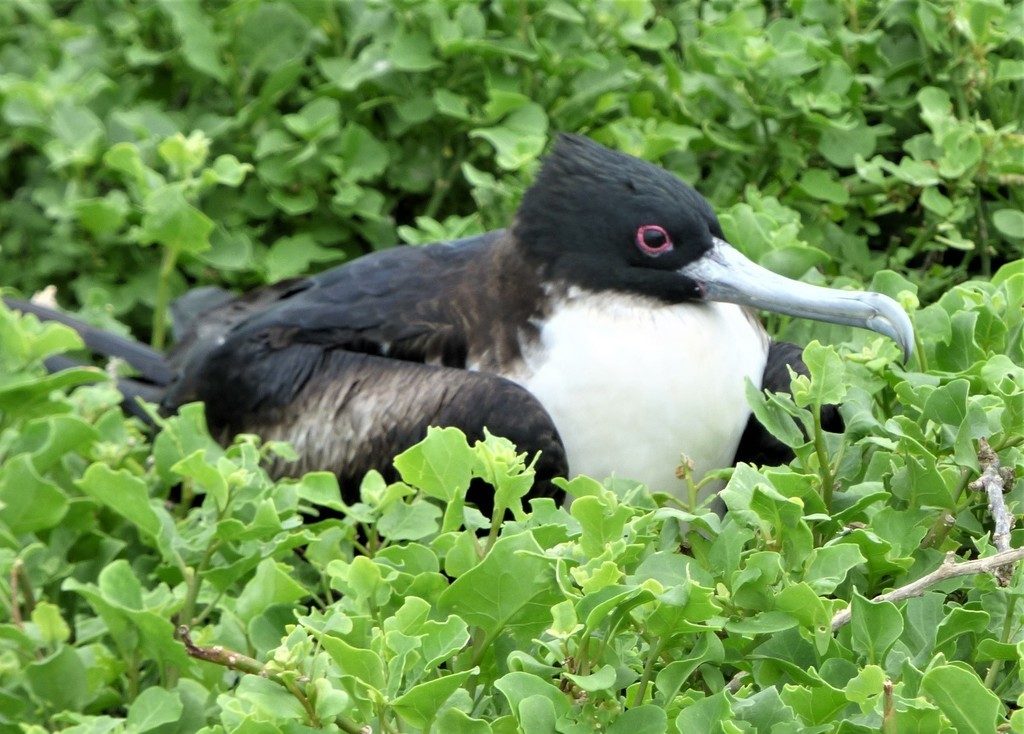
Great Frigatebird, female. (Darwin Bay, Isla Genovesa, Galápagos, Ecuador; June 8, 2015.) © Douglas Riverside

Great Frigatebird, female showing pale alar bars. (Isla Santa Cruz, Galápagos, Ecuador; December 15, 2002.) © Emily Turteltaub Nelson
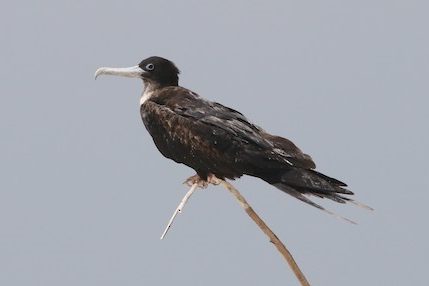
Great Frigatebird, female showing uniformly brown wings (alar bars indistinct at most). (Michaelmas Cay, Queensland, Australia; November 9, 2018.) © James Bailey
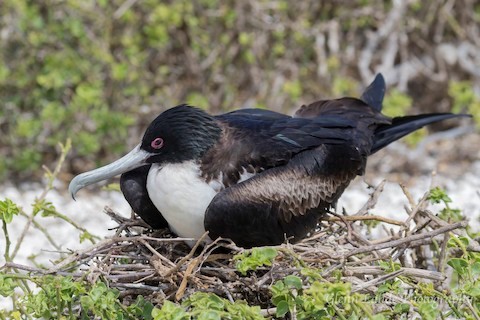
Great Frigatebird, female showing pale alar bars. (Darwin Bay, Isla Genovesa, Galápagos, Ecuador; June 7, 2018.) © Glenn Lahde

Great Frigatebird, female showing some green gloss on head and back. (North Seymour Island, Galápagos, Ecuador; March 25, 2018.) © John Reynolds
Juveniles and Older Immatures. Young Great Frigatebirds are highly variable, beginning with two very different-looking juvenile plumage morphs: one colorful and the other plain.
The colorful plumage is black overall with mostly white underparts and a tawny head, neck, and chest. The tawny color varies in intensity from pale-buff to orange or reddish. (This morph resembles juvenile Lesser and Christmas Frigatebirds.)
The plain plumage is black overall with mostly white head, neck, and underparts. (This morph resembles juvenile Magnificent.)
The juvenal plumage often has a dark breastband—sometimes partial, sometimes complete and broad—on some individuals, only the belly appears white. The breastband tends to disappear during the first year, lightening the underparts.
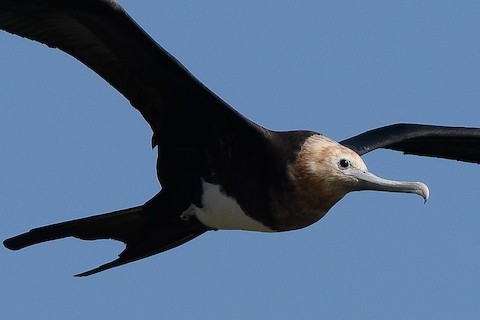
Great Frigatebird, juvenile with tawny head. (Christmas Island; August 28, 2019.) © Richard Smart

Great Frigatebird, juvenile with tawny head-to-chest. (Prince Philip’s Steps, Isla Genovesa, Galápagos, Ecuador; November 8, 2018.) © Joshua D. Vandermeulen
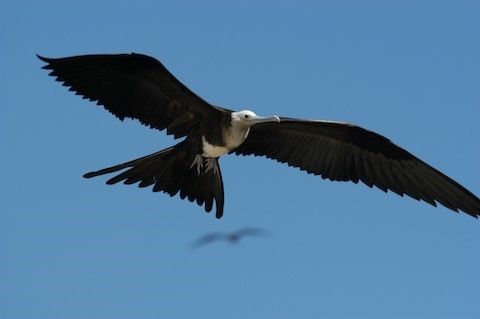
Great Frigatebird, juvenile with grayish-white head-to-chest. (Darwin Bay, Isla Genovesa, Galápagos, Ecuador; May 19, 2006.) © Marvin Hyett

Great Frigatebird, juvenile with tawny head and neck. (North Seymour Island, Galápagos, Ecuador; October 29, 2014.) © Carmelo López Abad

Great Frigatebird, juvenile showing typical pattern: tawny head and neck, black vest, and white belly. (Tench Island, New Ireland, Papua New Guinea; July 10, 2016.) © Charles Davies
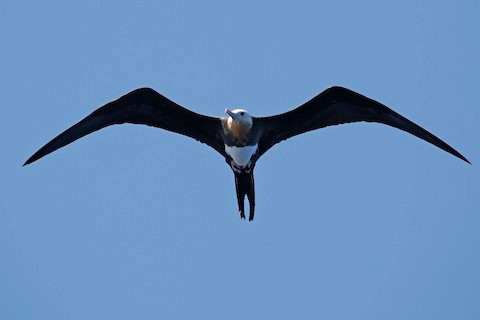
Great Frigatebird, juvenile showing typical pattern: tawny head and neck, black vest, and white belly. (South of Ni’ihau, Hawaii; October 14, 2019.) © Laura Keene
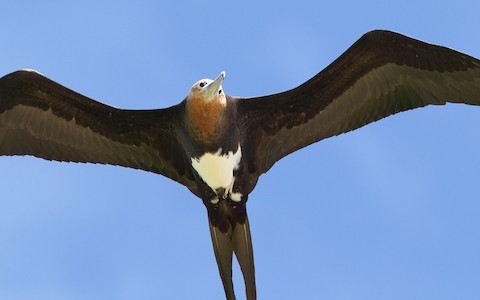
Great Frigatebird, juvenile showing typical pattern: tawny or rusty head and neck, black vest, and white belly. (Tench Island, New Ireland, Papua New Guinea; July 13, 2014.) © Lars Petersson

Great Frigatebird, juvenile with tail held closed—at a distance, appears all-dark with white “oval” on belly. (Taitung County, Taiwan; May 14, 2017.) © 許 宸

Great Frigatebird, juvenile with tail held open—at a distance, appears all-dark with white “oval” on belly. (Christmas Island; August 28, 2019.) © Mark and Angela McCaffrey
First-cycle immatures have almost entirely white underparts, usually with no breastband. The head can be either white or buffy (usually remaining colorful later on the throat.
Second-cycle birds develop some darker patches mainly on the belly, then later on the head. Afterward both sexes tend to resemble adult females before eventually differentiating.
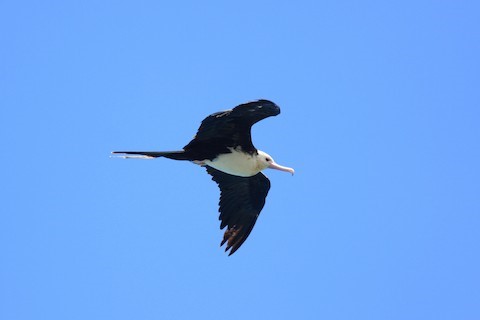
Great Frigatebird, immature with all-white underparts, buffy head, and pink bill. (Aride, Seychelles; October 22, 2019.) © Oscar Campbell
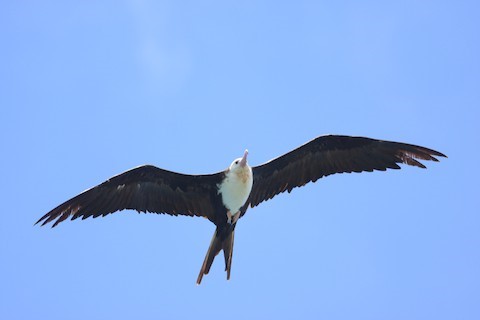
Great Frigatebird, immature with all-white underparts, buffy head, and pink bill. (Aride, Seychelles; October 22, 2019.) © Oscar Campbell

Great Frigatebird, immature with pink bill, developing spots on the belly. (Aldabra, Seychelles; February 8, 2008.) © Brieuc Fertard

Great Frigatebird, immature with buffy head, especially on throat, developing spots on the belly. (Kilauea Point National Wildlife Refuge, Kauai, Hawaii; May 3, 2016.) © Jacob Drucker

Great Frigatebird, immature with belly blackened and head beginning to darken. (Kilauea Point National Wildlife Refuge, Kauai, Hawaii; October 17, 2018.) © Garrett Lau
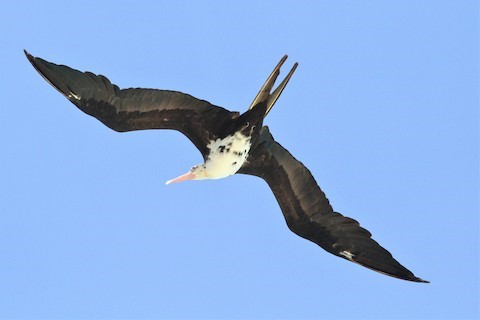
Great Frigatebird, immature with pink bill, developing spots on the belly. (Curieuse Island, Seychelles; August 27, 2019.) © Alex Bayly

Great Frigatebird, immature showing pale head and alar bars. (Kilauea Point National Wildlife Refuge, Kauai, Hawaii; May 14, 2020.) © Eric VanderWerf
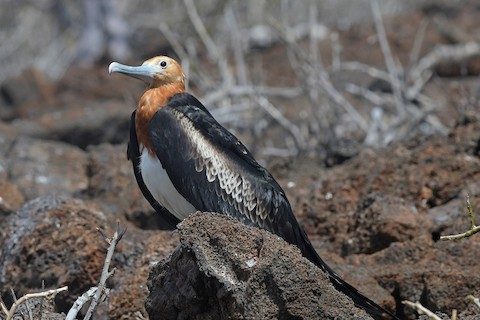
Great Frigatebird, juvenile with rich rusty head, neck, and chest. (Darwin Bay, Isla Genovesa, Galápagos, Ecuador; November 8, 2018.) © Joshua D. Vandermeulen
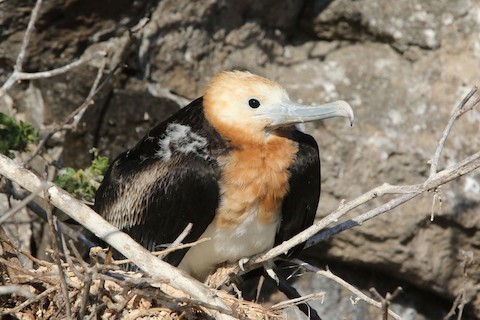
Great Frigatebird, juvenile with tawny or rusty head, neck, and chest. (Prince Philip’s Steps, Isla Genovesa, Galápagos, Ecuador; December 18, 2017.) © Olivier Langrand
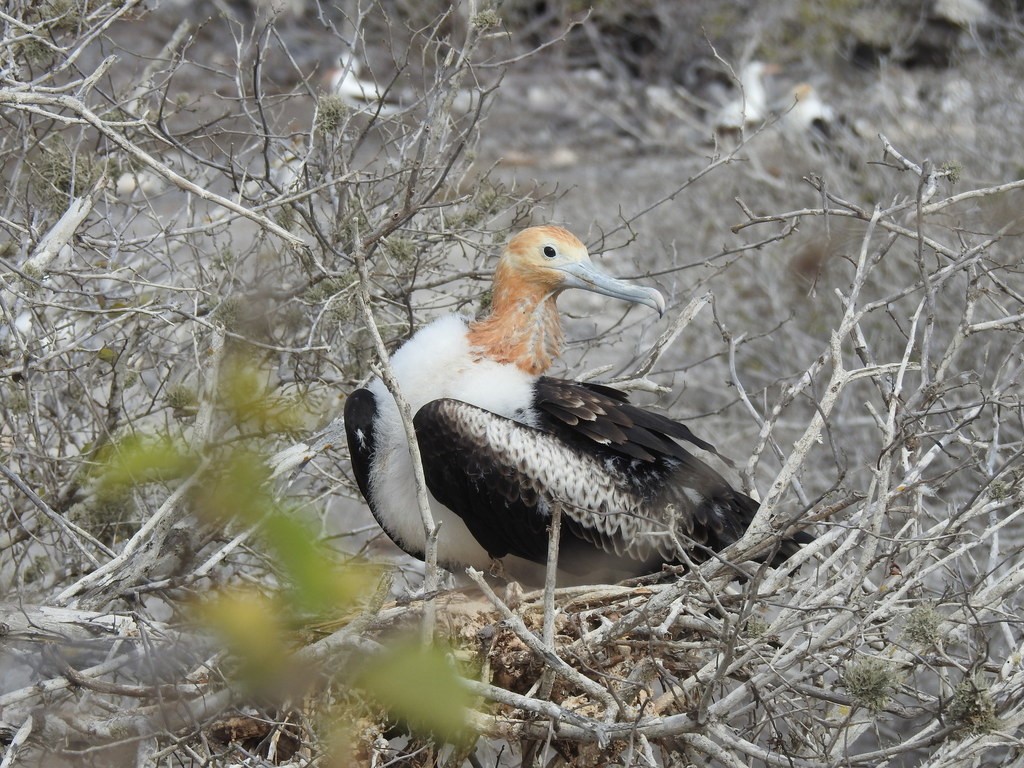
Great Frigatebird, juvenile, still downy, with rusty head and neck. (Isla San Cristóbal, Galápagos, Ecuador; October 19 2019.) © Louise

Great Frigatebird, juvenile showing buffy head and pale alar bar. (Hatutu, Marquesas Islands, French Polynesia; September 25, 2013.) © Josep del Hoyo
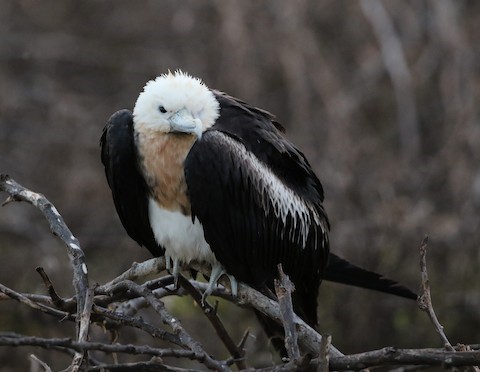
Great Frigatebird, juvenile with whitish head and much darker rusty-and-brown vest. (North Seymour Island, Galápagos, Ecuador; January 20, 2017.) © Richard Greenhalgh

Great Frigatebird, juvenile with pale-buffy head and darker rusty-and-brown vest. (North Seymour Island, Galápagos, Ecuador; January 20, 2017.) © Richard Greenhalgh
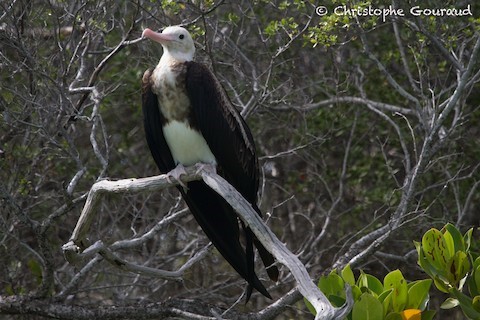
Great Frigatebird, juvenile with whitish head and darker coffee-brown vest. (Picard, Seychelles; December 5, 2018.) © Christophe Gouraud
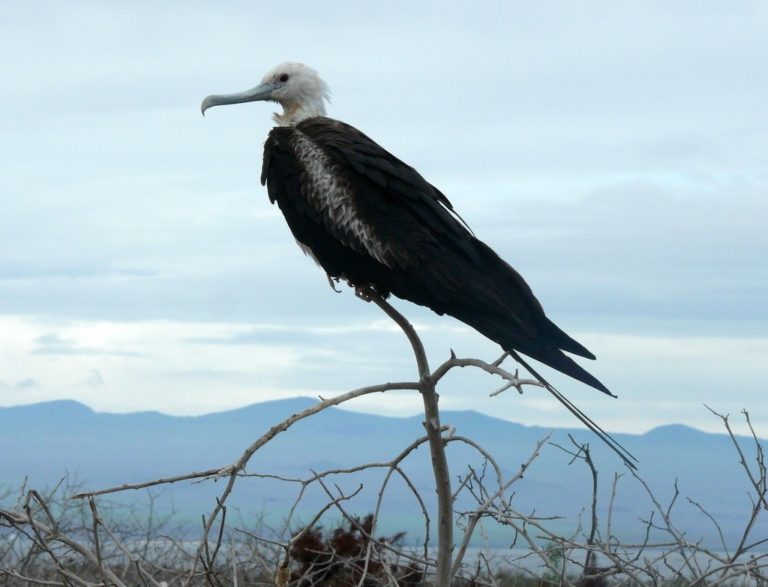
Great Frigatebird, juvenile showing whitish head and pale alar bar. (North Seymour Island, Galápagos, Ecuador; February 16, 2010.) © Victor W. Fazio III
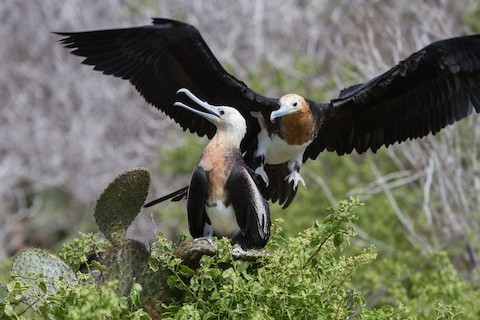
Great Frigatebird, juveniles with pale heads and darker rusty necks. (Darwin Bay, Isla Genovesa, Galápagos, Ecuador; January 10, 2015.) © Brad Dawson
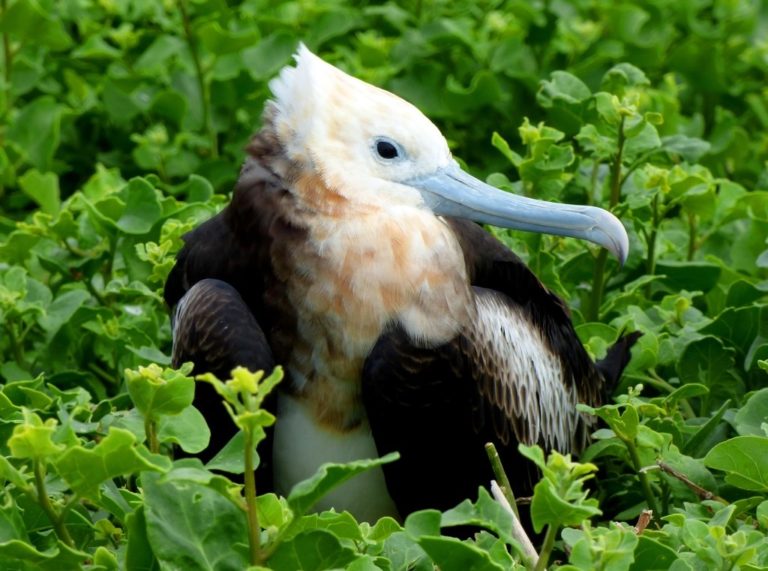
Great Frigatebird, juvenile with whitish head and rustier neck. (Darwin Bay, Isla Genovesa, Galápagos, Ecuador; June 8, 2015.) © Douglas Riverside
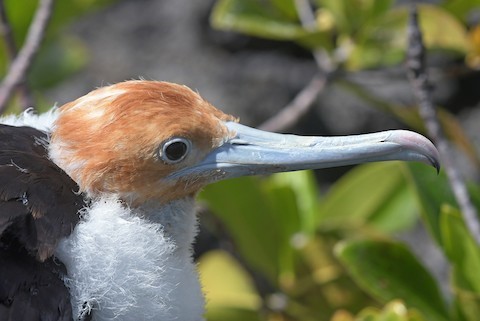
Great Frigatebird, downy juvenile with rusty head and downy white neck. (Darwin Bay, Isla Genovesa, Galápagos, Ecuador; November 8, 2018.) © Joshua D. Vandermeulen
Subadult Female. Subadult females go through intermediate stages in which the white on the head and belly fills in with darker feathers.

Great Frigatebird, subadult female with head darkening. (Kilauea Point National Wildlife Refuge, Kauai, Hawaii; March 21, 2017.) © Laurens Halsey
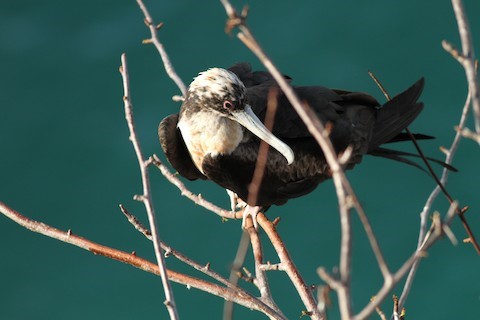
Great Frigatebird, subadult female with head darkening. (Cerro Tijeretas, San Cristóbal, Galápagos, Ecuador; February 9, 2015.) © David Weber

Great Frigatebird, subadult female with black belly and head just beginning to darken. (Makapu’u Point, Oahu, Hawaii; August 2, 2017.) © Sharif Uddin

Great Frigatebird, subadult female with head darkening. (Prince Philip’s Steps, Isla Genovesa, Galápagos, Ecuador; November 8, 2018.) © Joshua D. Vandermeulen
Subadult Male. Subadult males also go through various intermediate stages, first resembling adult females.
The belly usually becomes entirely black, causing them to resemble adult females: mostly blackish with a large white area on the chest and throat.
Eventually the white chest area fills in with black feathers. In the final stage, the plumage is essentially all-black, but with a slightly paler chest or throat and a few whitish streaks in the armpits.

Great Frigatebird, subadult male showing pronounced whitish area on chest. (Maui, Hawaii; September 3, 2016.) © Timothy Reichard
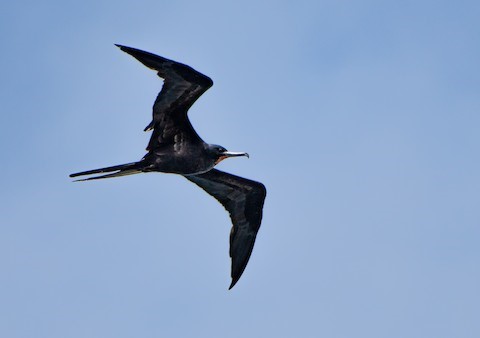
Great Frigatebird, subadult male, showing whitish marking in armpit—similar to male Lesser. (Lihua Islet, Hawaii; April 17, 2019.) © Lizabeth Southworth
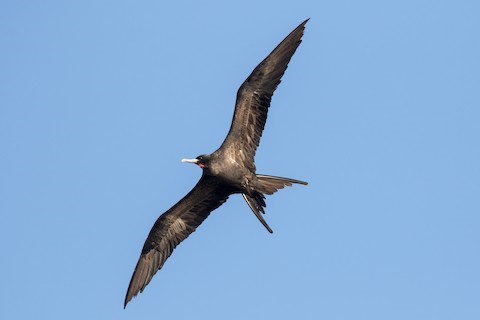
Great Frigatebird, subadult male—note vague remnant whitish area on chest. (Motu Nui / Motu Iti, Easter Island, Chile; March 19, 2019.) © Garrett Lau
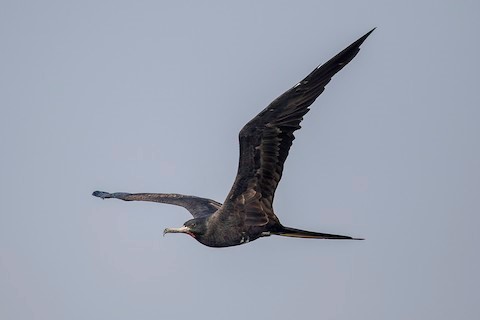
Great Frigatebird, subadult male. (Jakarta Bay, Java, Indonesia; August 5, 2018.) © Matthew Kwan

Great Frigatebird, subadult male, showing whitish markings in armpits—similar to male Lesser. (Koki Beach Park, Maui, Hawaii; July 16, 2017.) © Cullen Hanks

Great Frigatebird, subadult male, showing whitish markings in armpits—similar to male Lesser. (Koki Beach Park, Maui, Hawaii; July 16, 2017.) © Cullen Hanks
Cf. Lesser Frigatebird. Great and Lesser Frigatebirds overlap widely from the South Atlantic east across the Indian Ocean and across most of the Pacific. Despite being nominal opposites, they differ only marginally in size. Adults of the two species are readily distinguishable, but the immature plumages are complex and confusing.
Adult Males: Distinctive. Male Great is essentially all-black, and male Lesser is readily recognized by its white armpit markings (usually conspicuous, but somewhat variable and can be subtle on some individuals).
Adult Females: Distinctive. Lesser has a full blackish hood, whereas Great has a pale throat.

Great Frigatebird, juvenile, showing white underparts limited to body—all-dark armpits. (South of Ni’ihau, Hawaii; October 14, 2019.) © Laura Keene
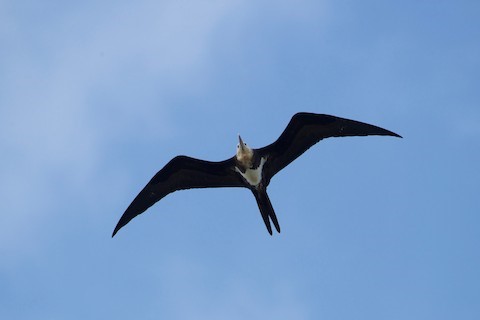
Lesser Frigatebird, juvenile, showing white underparts extending to armpits. (Nanhui Dongtan, Shanghai, China; August 2, 2018.) © Yasuhiko Kumatsu
Immatures: Usually distinguishable, but complicated. Juveniles and older immatures can usually be identified through a clear view of the underparts. Most distinctively, on Lesser the white area on the breast and belly projects into the armpits, whereas Great rarely shows such projections. Lesser also tends to have a more extensively black chest, but this varies within each species individually and by age, and there is some overlap between them.

Great Frigatebird, subadult female showing slight white projections into armpits. (Kilauea Point National Wildlife Refuge, Kauai, Hawaii; October 17, 2018.) © Garrett Lau
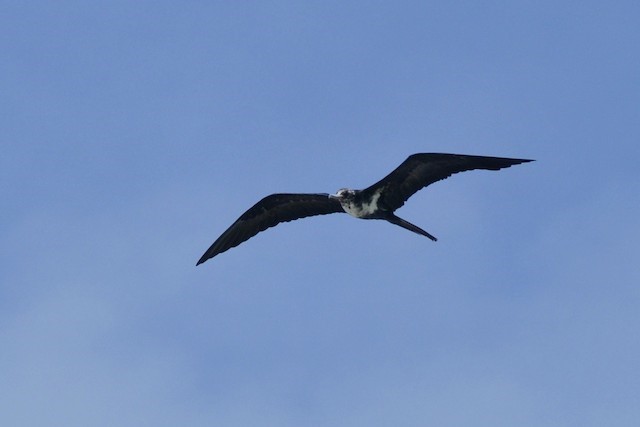
Lesser Frigatebird, subadult male, in molt-stage that resembles a female Great Frigatebird. (Ngaontetaae Island, Kiribati; November 5, 2016.) © John Doty
Subadult Females: Usually distinguishable, but complicated. Female Lessers begin to darken on the throat, whereas female Greats do not, so this may allow for positive identification of Lesser in some cases. Most confusing about these plumages, subadult female Greats often show white projections into the armpits, so that characteristic of Lesser is less diagnostic in these plumages.
Subadult Males: Distinctive, but complicated. Subadult males of both species develop similarly, darkening first on the head and belly, developing a blackish hood and white vest, then becoming mottled throughout its underparts, but remaining whitest on the chest. The main difference is, as in adult males, Lesser’s white armpit markings.
Cf. Magnificent Frigatebird. Magnificent and Great Frigatebirds occur together regularly in the Galápagos and Ecuadorian waters, around remote Mexican islands, and to a very limited extent in Brazilian waters. They likely occur together somewhat more often in the eastern Pacific, but would be difficult to recognize due to their confusing similarities and the difficulty of tracking the various distinctions that apply to certain plumages.
Adult Males: Effectively indistinguishable under most field conditions. If the upperparts are visible, the presence of a distinct alar bar on the wings would suggest Great. If the lighting is right to catch reflections, Great often shows a strong green or purple gloss on the back feathers, whereas Magnificent is usually duller and purplish or coppery.
Adult Females: Distinctive. Magnificent has a full blackish hood, whereas Great has a pale throat. In the eastern Pacific populations, which are most likely to occur together, the females also differ in their eyerings: bluish on Magnificent, red on Great. Bill color differs accordingly, but to a lesser extent.
Immatures: Often distinctive, but complex and sometimes indistinguishable. Juveniles and older immatures are often distinguishable, as most juvenile Greats have a tawny (or buffy or orange or reddish) hood, which they retain at least in part into the second year. However, immature Greats are polymorphic and some portion of them have an all-white head like Magnificent—in which case there may be no reliable difference. As they age, the differences become less pronounced, such that second-cycle immatures are mostly similar both within and between the two species.
Subadult Females: Sometimes distinguishable, but complicated. Female Magnificents begin to darken on the throat, whereas female Greats do not, so this may allow for positive identification of Magnificent in some cases. Female Greats often have pinkish bills, while female Magnificent’s bill is generally pale grayish or horn-colored.

Magnificent Frigatebird, female, showing white markings projecting into the armpits—similar to female Lesser Frigatebird. (Cancún, Quintana Roo, Mexico; February 17, 2015.) © Alexandre Gualhanone

Lesser Frigatebird, subadult female. (Lady Elliot Island, Queensland, Australia; March 14, 2020.) © Barry Deacon
Subadult Males: Distinctive, but complicated. The subadult male Magnificent is unique; it darkens in patches and becomes mottled throughout its underparts, usually remaining whitest on the belly. The subadult male Great darkens first on the head and belly, developing a blackish hood and white vest. The resulting pattern first resembles the adult female Great, then the adult female Magnificent, except that the shape of the white vest is different: somewhat U-shaped.
Cf. Christmas Frigatebird. Christmas and Great Frigatebirds occur together throughout Indonesia, the Timor, Banda, and Arafura Seas, and in nearby portions of the eastern Indian and western Pacific Oceans. Adult plumages of the two species are distinctive, but immatures are readily confused.
Adult Males: Distinctive. Male Christmas is black with a white belly and male Great is essentially all-black.
Adult Females: Distinctive. Female Christmas has a full black hood and white belly, whereas female Great has a pale throat and black belly.
Immatures: Usually distinguishable, but complicated. Most confusing are the juvenile and other immature plumages, which vary widely and can be essentially identical in color and pattern. Until Great’s belly begins to darken, the most consistent difference is that Christmas’s white underparts extend into its armpits.
Subadult Females: Usually distinguishable. As the sexes differentiate, Christmas and Great Frigatebirds become easier to identify based on the color of the belly. Christmas’s belly is always white (at least mostly white), whereas subadult Greats of both sexes darken on the belly while retaining an all- or mostly white chest.
Subadult Males: Distinctive. Male Christmas is black with a white belly and male Great is essentially all-black. Christmas’s belly is always white (at least mostly white), whereas subadult Greats of both sexes darken on the belly while retaining an all- or mostly white chest.
Notes
Polytypic species consisting of five recognized subspecies.
References
BirdLife International. 2018. Fregata minor. The IUCN Red List of Threatened Species 2018: e.T22697733A132598124. https://dx.doi.org/10.2305/IUCN.UK.2018-2.RLTS.T22697733A132598124.en. (Accessed August 8, 2020.)
Brazil, M. 2009. Birds of East Asia. Princeton University Press.
eBird. 2020. eBird: An online database of bird distribution and abundance. Cornell Lab of Ornithology, Ithaca, N.Y. http://www.ebird.org. (Accessed August 8, 2020.)
Harrison, P. 1983. Seabirds: An Identification Guide. Houghton Mifflin, Boston.
Hawaii Audubon Society. 2005. Hawaii’s Birds (Sixth Edition). Island Heritage Publishing, Waipahu, Hawaii.
Howell, S.N.G., and S. Webb. 1995. A Guide to the Birds of Mexico and Northern Central America. Oxford University Press.
Howell, S.N.G., I. Lewington, and W. Russell. 2014. Rare Birds of North America. Princeton University Press.
Howell, S.N.G., and K. Zufelt. 2019. Oceanic Birds of the World. Princeton University Press.
Port, D., J.O. Branco, C.E. de Alvarez, and F. Fisch. 2016. Observations on endangered frigatebirds (Fregata ariel trinitatis and F. minor nicolli, Suliformes: Fregatidae) at Trindade Island, Brazil. Pan-American Journal of Aquatic Sciences 11:87-92.
Pratt, H.D., P.L. Bruner, and D.G. Berrett. 1987. A Field Guide to the Birds of Hawaii and the Tropical Pacific. Princeton University Press.
Pyle, R.L., and P. Pyle. 2017. The Birds of the Hawaiian Islands: Occurrence, History, Distribution, and Status. Version 2 (January 1, 2017). http://hbs.bishopmuseum.org/birds/rlp-monograph/. B.P. Bishop Museum, Honolulu, Hawaii.
Silva e Silva, R., and C.J. Carlos. 2019. A Great Frigatebird Fregata minor at Fernando de Noronha archipelago, equatorial Atlantic Ocean. Bulletin of the British Ornithologists’ Club 139:333-337.
Sinclair, I., P. Hockey, W. Tarboton, and P. Ryan. 2011. Birds of Southern Africa (Fourth Edition). Random House Struik (Pty) Ltd. Cape Town, South Africa.
van Perlo, B. 2009. A Field Guide to the Birds of Brazil. Oxford University Press.

